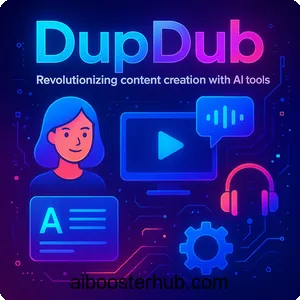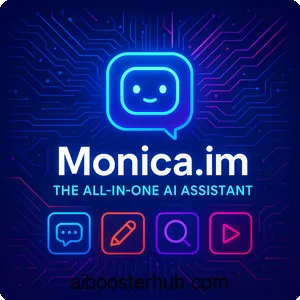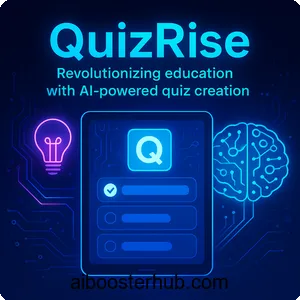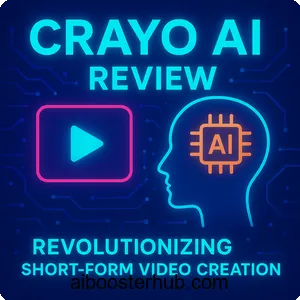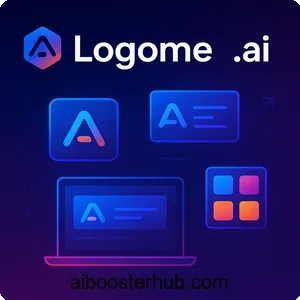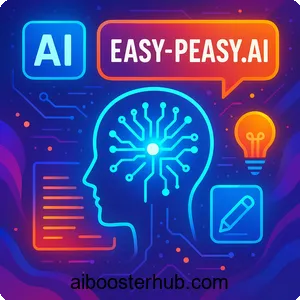Free AI Image Generation: 10 Best AI Image Generators
The world of AI image generators has transformed how we create visuals, making it easier than ever to create images from AI prompts. Whether you’re a designer, marketer, content creator, or just someone exploring AI creative tools, the ability to generate stunning, high-quality images for free is a game-changer. In this article, we dive into the 10 best free AI image generators, providing detailed platform reviews, usage tutorials, output quality comparisons, commercial use guidelines, and prompt engineering tips to help you maximize their potential.
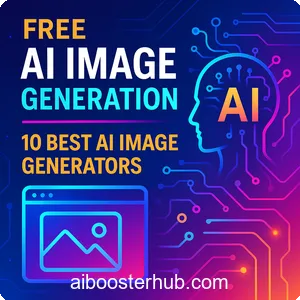
Content
Toggle1. Why AI image generators are a must-have for creatives
AI image generators have revolutionized the creative process by enabling users to produce professional-grade visuals without needing advanced design skills. These tools use sophisticated algorithms, often trained on millions of images, to interpret text prompts and generate unique visuals. Whether you’re crafting social media graphics, blog illustrations, product mockups, or concept art, AI creative tools offer a fast, cost-effective solution.
The appeal of free AI image generators lies in their accessibility. Many platforms provide generous free tiers, allowing users to experiment without financial commitment. However, not all tools are created equal—some excel in photorealism, others in artistic styles, and some prioritize ease of use or commercial licensing. This guide will help you navigate the top options, ensuring you find the right tool for your creative needs.
Benefits of using AI image generators
- Speed and efficiency: Generate high-quality images in seconds, saving hours compared to traditional design methods.
- Cost-effective: Free tiers make these tools accessible to beginners, small businesses, and hobbyists.
- Versatility: Create everything from realistic photos to abstract art, tailored to your project’s style.
- Commercial use potential: Many platforms offer royalty-free images, ideal for marketing, branding, or product design.
- No design skills required: Intuitive interfaces and prompt engineering tips make it easy for anyone to create stunning visuals.
Key considerations when choosing a tool
When selecting an AI image generator, consider your use case (e.g., social media, concept art, or marketing), desired output quality, and whether commercial use is allowed. Features like style presets, negative prompts, and editing tools can also enhance your workflow. Below, we review the top 10 free platforms, comparing their strengths, usability, and output quality.
2. Top 10 free AI image generators
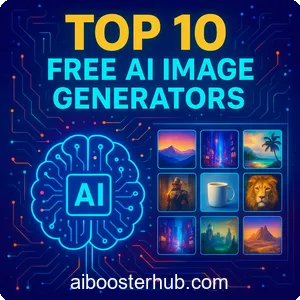
Here’s a detailed look at the 10 best free AI image generators, each chosen for its unique features, output quality, and ease of use. These platforms cater to a range of needs, from photorealistic imagery to artistic illustrations, and all offer free tiers for users to explore.
Adobe Firefly
Adobe Firefly integrates seamlessly with Adobe’s creative ecosystem, making it a top choice for professionals already using tools like Photoshop. Trained on Adobe Stock images and licensed content, Firefly produces high-quality, commercially safe images. Its Text to Image tool is user-friendly, allowing users to input detailed prompts and generate four image variations. Features like Generative Fill and Expand let you edit or extend images with text prompts, ensuring cohesive results.
Usage tutorial: Log in with a free Adobe account, select the Text to Image tool, and enter a descriptive prompt (e.g., “A serene mountain landscape at sunset, photorealistic, vibrant colors”). Adjust settings like aspect ratio or style, then click Generate. Refine results by tweaking the prompt or using editing tools.
Output quality: Firefly excels in photorealism and professional-grade visuals, with excellent lighting and texture. It’s ideal for marketing materials and creative projects.
Commercial use guidelines: Images are safe for commercial use, with clear licensing terms ensuring no copyright issues.
Microsoft Designer
Microsoft Designer, powered by DALL-E 3, offers a straightforward AI image generator for creating high-quality visuals. Its integration with the Microsoft ecosystem makes it convenient for users who need images for presentations, social media, or marketing. The platform is free with a Microsoft account and supports unlimited image generation.
Usage tutorial: Sign in, describe your image (e.g., “A futuristic cityscape, cyberpunk style, neon lights”), and select Generate. Customize outputs with Designer’s editing tools, like background removal or text overlays.
Output quality: Produces sharp, detailed images with strong prompt adherence, particularly for realistic and web-friendly visuals.
Commercial use guidelines: Images are royalty-free for personal and commercial use, making it a versatile option.
Canva Magic Media
Canva’s Magic Media tool brings AI creative tools to its popular design platform. With options like Text to Image and Create an Image (powered by Dream Lab), Canva is beginner-friendly and ideal for social media graphics, blog visuals, and branding.
Usage tutorial: Access Magic Media in Canva, enter a prompt (e.g., “A watercolor painting of a tropical beach”), and choose an art style. Generate images and edit them using Canva’s drag-and-drop tools for further customization.
Output quality: Offers vibrant, customizable images with a focus on graphic and illustrative styles. Prompt adherence is strong, though complex prompts may require refinement.
Commercial use guidelines: Images are safe for commercial use, with automated safety checks to prevent inappropriate content.
Craiyon
Craiyon, formerly DALL-E mini, is a free AI image generator with no login required. It’s perfect for casual users looking to experiment with AI free images. The platform supports a variety of styles, from photorealistic to vector art.
Usage tutorial: Visit Craiyon’s website, enter a prompt (e.g., “A steampunk robot in a Victorian city”), select a style, and click Draw. Refine results by adjusting prompts or using the Exclude field to avoid unwanted elements.
Output quality: Produces decent-quality images, though less sharp than premium tools. It’s best for creative exploration rather than professional use.
Commercial use guidelines: Images are public domain, allowing commercial use, but quality limitations may restrict professional applications.
Pixelcut
Pixelcut’s AI image generator focuses on high-resolution, commercially viable images. It supports multiple models like Flux and Ideogram, offering flexibility for different creative needs.
Usage tutorial: Enter a detailed prompt (e.g., “A minimalist product shot of a coffee mug, studio lighting”), choose a model, and select an aspect ratio. Download the generated image for immediate use.
Output quality: Excels in realistic textures and lighting, with minimal artifacts. It’s ideal for e-commerce and marketing.
Commercial use guidelines: Offers a royalty-free license for all images, making it a top choice for business applications.
Freepik AI Image Generator
Freepik’s tool integrates multiple AI models, including Flux and Google Imagen, to deliver versatile, high-quality images. It’s free for up to 20 images daily and supports a range of styles.
Usage tutorial: Input a prompt (e.g., “A hyper-realistic portrait of a lion, golden hour lighting”), select a model, and generate. Use Freepik’s editing suite to refine images or adjust styles.
Output quality: Produces sharp, detailed images with excellent prompt adherence, especially for photorealistic outputs.
Commercial use guidelines: Images are cleared for personal and commercial use, backed by licensed training data.
DeepAI
DeepAI offers a free AI image generator with no sign-up required, making it accessible for quick experimentation. It supports various artistic styles and smart customization options.
Usage tutorial: Enter a prompt (e.g., “A cyberpunk city at night, neon colors”), select a style like photorealistic or watercolor, and generate. Adjust lighting or composition for better results.
Output quality: Good for creative projects but may lack the sharpness of premium tools. It’s reliable for artistic and experimental visuals.
Commercial use guidelines: Images are public domain and can be used commercially, though higher-resolution options are limited.
QuillBot AI Image Generator
QuillBot’s free tool is designed for speed and ease, offering up to three images daily for free users. It’s ideal for quick visuals for blogs or social media.
Usage tutorial: Log in, enter a prompt (e.g., “A fantasy castle in a misty forest, cinematic lighting”), and generate. Download high-resolution images or refine prompts for better results.
Output quality: Produces sharp, coherent images with good prompt adherence, though limited daily credits restrict heavy use.
Commercial use guidelines: Images come with a full commercial license, suitable for marketing and personal projects.
ImagineArt
ImagineArt combines image, video, and voice generation, with a free tier for image creation. It’s popular for its advanced editing tools and community-driven inspiration.
Usage tutorial: Enter a prompt (e.g., “A surreal desert landscape, Dali-inspired”), select a model, and generate. Use tools like BG Remover or Upscaler to refine outputs.
Output quality: Offers high-quality, stylized images, particularly for artistic and surreal visuals.
Commercial use guidelines: Images are royalty-free, making them suitable for commercial projects.
MyEdit
MyEdit stands out with its Prompt from Image feature, allowing users to generate text descriptions from uploaded images. It’s versatile for both text-to-image and image-to-image workflows.
Usage tutorial: Input a prompt (e.g., “A futuristic spaceship in orbit, sci-fi art style”) or upload a reference image. Generate and edit with tools like background removal or Generative Fill.
Output quality: Delivers detailed, customized images with strong support for creative styles.
Commercial use guidelines: Images are royalty-free and safe for commercial use, ideal for professional projects.
3. Output quality comparisons
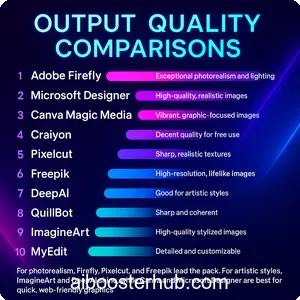
When evaluating AI image generators, output quality is a critical factor. Here’s how the top 10 platforms compare based on key metrics like sharpness, prompt adherence, and style versatility:
- Adobe Firefly: Exceptional photorealism and lighting, ideal for professional-grade visuals. Minimal artifacts and strong prompt adherence.
- Microsoft Designer: High-quality, realistic images with excellent detail, particularly for web-friendly graphics.
- Canva Magic Media: Vibrant, graphic-focused images with good prompt adherence, though less suited for complex photorealistic prompts.
- Craiyon: Decent quality for free use, but images may lack sharpness compared to premium tools.
- Pixelcut: Sharp, realistic textures with minimal artifacts, perfect for e-commerce and marketing.
- Freepik: High-resolution, lifelike images with strong prompt adherence, especially with Flux and Imagen models.
- DeepAI: Good for artistic styles but less sharp for photorealistic outputs.
- QuillBot: Sharp and coherent, though limited daily credits may restrict testing.
- ImagineArt: High-quality stylized images, particularly for surreal and artistic visuals.
- MyEdit: Detailed and customizable, with strong support for both photorealistic and creative styles.
For photorealism, Firefly, Pixelcut, and Freepik lead the pack. For artistic styles, ImagineArt and DeepAI shine, while Canva and Microsoft Designer are best for quick, web-friendly graphics.
4. Usage tutorials for beginners
Getting started with AI image generators is simple, even for beginners. Here’s a step-by-step guide to using these tools effectively:
- Choose a platform: Select a tool based on your needs (e.g., Firefly for professional visuals, Craiyon for casual experimentation).
- Sign up or access: Most platforms require a free account, though some like Craiyon and DeepAI need no login.
- Write a prompt: Use descriptive language, including subject, style, lighting, and mood (e.g., “A futuristic city at dusk, cyberpunk style, neon lights, cinematic”). See prompt engineering tips below for more.
- Customize settings: Adjust aspect ratio, style presets, or negative prompts to refine results.
- Generate and refine: Generate images, review outputs, and tweak prompts or settings for better results.
- Edit and download: Use built-in editing tools (if available) to enhance images, then download for use.
Many platforms offer additional features like upscaling, background removal, or Generative Fill. Experiment with these to enhance your workflow.
5. Prompt engineering tips for better results
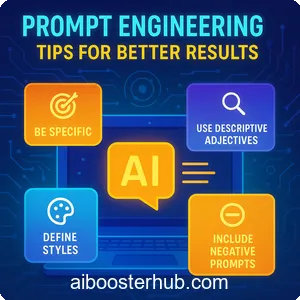
Crafting effective prompts is key to getting high-quality AI free images. Here are prompt engineering tips to optimize your results:
- Be specific: Include details like subject, style, lighting, and mood (e.g., “A majestic dragon flying over a snowy mountain, fantasy art, dramatic lighting”).
- Use descriptive adjectives: Words like “vibrant,” “minimalist,” or “cinematic” guide the AI’s output.
- Define styles: Specify styles like “photorealistic,” “watercolor,” or “anime” for consistent results.
- Include negative prompts: Use negative prompts (e.g., “no text, no extra limbs”) to avoid unwanted elements.
- Iterate and refine: If the output isn’t perfect, tweak your prompt or adjust settings like aspect ratio.
- Experiment with seeds: Some platforms allow you to reuse seed numbers for consistent styles.
- Test variations: Generate multiple images to explore different interpretations of your prompt.
For example, instead of “A dog,” try “A golden retriever playing in a sunny park, photorealistic, vibrant colors, shallow depth of field.” This level of detail improves output quality across all platforms.
6. Commercial use guidelines
Using AI-generated images for commercial purposes requires understanding each platform’s licensing terms. Here’s a summary of commercial use guidelines for the top 10 tools:
- Adobe Firefly: Images are safe for commercial use, trained on licensed Adobe Stock content.
- Microsoft Designer: Royalty-free for personal and commercial use, backed by DALL-E 3.
- Canva Magic Media: Commercially safe with automated safety checks to ensure compliance.
- Craiyon: Public domain images, usable commercially, but quality may limit professional applications.
- Pixelcut: Royalty-free license for all images, ideal for e-commerce and marketing.
- Freepik: Cleared for personal and commercial use, backed by licensed training data.
- DeepAI: Public domain images, suitable for commercial use, though resolution may be limited.
- QuillBot: Full commercial license for all images, even on the free plan.
- ImagineArt: Royalty-free images, suitable for commercial projects.
- MyEdit: Royalty-free and safe for commercial use, ideal for professional applications.
Always review the platform’s terms of service to confirm licensing details, especially for high-volume commercial projects. Some platforms may require attribution or limit usage in free tiers.
7. Choosing the right AI image generator for you
Selecting the best AI image generator depends on your specific needs. Here’s a quick guide to help you choose:
- For professionals: Adobe Firefly and Freepik offer high-quality, commercially safe images with robust editing tools.
- For beginners: Canva Magic Media and Microsoft Designer are user-friendly with intuitive interfaces.
- For casual users: Craiyon and DeepAI require no sign-up and are great for quick experimentation.
- For e-commerce: Pixelcut and MyEdit excel in realistic, high-resolution visuals for product shots.
- For artists: ImagineArt and DeepAI shine in stylized, creative outputs.
- For social media: Canva, QuillBot, and Microsoft Designer are ideal for fast, web-friendly graphics.
Experiment with multiple platforms to find the one that best aligns with your creative goals. Most offer free tiers, so you can test their features and output quality before committing to a workflow.
8. Conclusion
The rise of AI image generators has democratized creativity, allowing anyone to create images from AI with minimal effort. From Adobe Firefly’s professional-grade visuals to Craiyon’s no-login accessibility, these 10 free AI creative tools offer something for everyone. By leveraging prompt engineering tips, understanding commercial use guidelines, and comparing output quality, you can unlock the full potential of AI free images for your projects.
Whether you’re a marketer, designer, or hobbyist, these platforms empower you to bring your ideas to life. Start experimenting today, refine your prompts, and discover how AI image generators can transform your creative workflow. Which tool will you try first?

